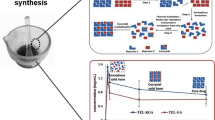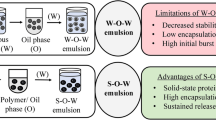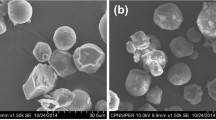Abstract
Purpose
Croscarmellose sodium, generally used as a superdisintegrant in pharmaceutical formulations, is hydrolyzed to form the gel structure under basic pH conditions. Utilizing this property of croscarmellose sodium, we developed a novel sustained release (SR) system.
Methods
Immediate release (IR) and SR tablets containing croscarmellose sodium, alkaline excipients and/or hydroxypropyl methylcellulose (HPMC) were prepared and examined for wet strength and in vitro drug release behavior. In vivo oral drug absorption was evaluated for IR tablets, HPMC tablets and our novel SR tablets in fasted Beagle dogs.
Results
To form the gel structure even under the physiological condition, alkaline excipients were added into the formulation containing croscarmellose sodium. Furthermore, HPMC was used to make the gel structure strong enough against mechanical destructive forces. The novel alkalized croscarmellose sodium-HPMC (ACSH) SR tablet, consisting of croscarmellose sodium, alkaline excipients, and HPMC, successfully sustained the release of acetaminophen, ibuprofen, or nicardipine hydrochloride, compared with the IR tablets. The ACSH SR system provided a better release of acetaminophen than the HPMC tablet without croscarmellose sodium in the release study using a small volume of liquid, suggesting that substantial release and subsequent absorption would be expected in the distal intestinal segments after oral dosing. The in vivo oral absorption study revealed that the ACSH SR system successfully suppressed and prolonged the plasma concentrations of acetaminophen.
Conclusion
This novel ACSH SR system prepared with croscarmellose sodium, alkaline excipients, and HPMC, would be a promising SR formulation for enabling substantial drug absorption in the distal intestinal segments.








Similar content being viewed by others
Data Availability
Data will be made available on request.
References
Shen SI, Jasti BR, Li X. Chapter 22: Design of controlled-release drug delivery systems. In: Myer K, editor. Standard handbook of biomedical engineering and design, New York, The McGraw-Hill Companies, Inc. 2003.
Nokhodchi A, Raja S, Patel P, Asare-Addo K. The role of oral controlled release matrix tablets in drug delivery systems. BioImpacts. 2012;2:175–87. https://doi.org/10.5681/bi.2012.027.
Huang X, Brazel CS. On the importance and mechanisms of burst release in matrix-controlled drug delivery systems. J Control Release. 2001;73:121–36. https://doi.org/10.1016/s0168-3659(01)00248-6.
Ford JL, Mitchell K, Rowe P, Armstrong DJ, Elliott PNC, Rostron C, et al. Mathematical modelling of drug release from hydroxypropylmethylcellulose matrices: effect of temperature. Int J Pharm. 1991;71:95–104. https://doi.org/10.1016/0378-5173(91)90071-U.
Sako K, Mizumoto T, Kajiyama A, Ohmura T. Influence of physical factors in gastrointestinal tract on acetaminophen release from controlled-release tablets in fasted dogs. Int J Pharm. 1996;137:225–32. https://doi.org/10.1016/0378-5173(96)04524-3.
Michel MC, Korstanje C, Krauwinkel W, Kuipers M. The pharmacokinetic profile of tamsulosin oral controlled absorption system (OCAS®). Eur Urol Suppl. 2005;4:15–24. https://doi.org/10.1016/j.eursup.2004.11.002.
Hodges LA, Sime KA, Creech LA, Connolly SM, Barclay ST, Kwon MC, et al. Pharmacoscintigraphy confirms consistent tamsulosin release from a novel triple-layered tablet. Int J Pharm. 2013;454:41–6. https://doi.org/10.1016/j.ijpharm.2013.06.065.
Park JS, Shim JY, Park JS, Lee MJ, Kang JM, Lee SH, et al. Formulation variation and in vitro-in vivo correlation for a rapidly swellable three-layered tablet of tamsulosin HCl. Chem Pharm Bull (Tokyo). 2011;59:529–35. https://doi.org/10.1248/cpb.59.529.
Swarbrick J, Boylan JC. Encyclopedia of pharmaceutical technology. Marcel dekker, Inc. 1990;20:269–70.
Shangraw RF, Mitrevej A, Shah M. A new era of tablet disintegrants. Pharm Technol. 1980;4:49–57.
Balasubramaniam J, Bindu K, Rao VU, Ray D, Haldar R, Brzeczko AW. Effect of superdisintegrants on dissolution of cationic drugs. Dissolut Technol. 2008;15:18–25. https://doi.org/10.14227/DT150208P18.
Freeman C, Weiner ML, Kotkoskie LA, Borzelleca J, Butt M. Subchronic and developmental toxicity studies in rats with Ac-di-sol croscarmellose sodium. Int J Toxicol. 2003;22:149–57. https://doi.org/10.1080/10915810305108.
Bindra DS, Stein D, Pandey P, Barbour N. Incompatibility of croscarmellose sodium with alkaline excipients in a tablet formulation. Pharm Dev Technol. 2014;19:285–9. https://doi.org/10.3109/10837450.2013.778869.
Sutton SC. Role of physiological intestinal water in oral absorption. AAPS J. 2009;11:277–85. https://doi.org/10.1208/s12248-009-9087-2.
Wang C, Zhai B, Guo H, Wang P, Liu Z, Gu H, et al. In vivo measurement of gastric fluid volume in anesthetized dogs. J Drug Deliv Sci Technol. 2020;55: 101488. https://doi.org/10.1016/j.jddst.2019.101488.
Schiller C, Fröhlich CP, Giessmann T, Siegmund W, Mönnikes H, Hosten N, et al. Intestinal fluid volumes and transit of dosage forms as assessed by magnetic resonance imaging. Aliment Pharmacol Ther. 2005;22:971–9. https://doi.org/10.1111/j.1365-2036.2005.02683.x.
Varelas CG, Dixon DG, Steiner CA. Zero-order release from biphasic polymer hydrogels. J Control Rel. 1995;34:185–92. https://doi.org/10.1016/0168-3659(94)00085-9.
Dash S, Murthy PN, Nath L, Chowdhury P. Kinetic modeling on drug release from controlled drug delivery systems. Acta Pol Pharm. 2010;67:217–23.
Costa P, Sousa Lobo JM. Modeling and comparison of dissolution profiles. Eur J Pharm Sci. 2001;13:123–33. https://doi.org/10.1016/s0928-0987(01)00095-1.
Paarakh MP, Jose PA, Setty C, Christoper GP. Release kinetics – concepts and applications. IJPRT. 2018;8:12–20.
Mulye N, Turco S. A simple model based on first order kinetics to explain release of highly water soluble drugs from porous dicalcium phosphate dihydrate matrices. Drug Dev Ind Pharm. 1995;21:943–53. https://doi.org/10.3109/03639049509026658.
Higuchi T. Mechanism of sustained-action medication. Theoretical analysis of rate of release of solid drugs dispersed in solid matrices. J Pharm Sci. 1963;52:1145–9. https://doi.org/10.1002/jps.2600521210.
Shoaib MH, Tazeen J, Merchant HA, Yousuf RI. Evaluation of drug release kinetics from ibuprofen matrix tablets using HPMC. Pak J Pharm Sci. 2006;19:119–24.
Korsmeyer RW, Gurny R, Doelker E, Peppas Buri P, NA,. Mechanisms of solute release from porous hydrophilic polymers. Int J Pharm. 1983;15:25–35. https://doi.org/10.1016/0378-5173(83)90064-9.
Langenbucher F. Linearization of dissolution rate curves by the Weibull distribution. J Pharm Pharmacol. 1972;24:979–81. https://doi.org/10.1111/j.2042-7158.1972.tb08930.x.
Hixon AW, Crowell JH. Dependence of reaction velocity upon surface and agitation. Ind Eng Chem. 1931;23:923–31. https://doi.org/10.1021/ie50260a018.
Kipcak AS, Ismail O, Doymaz I, Piskin S. Modeling and investigation of the swelling kinetics of acrylamide-sodium acrylate hydrogel. J Chem. 2014:1–8. https://doi.org/10.1155/2014/281063
Jastram A, Lindner T, Luebbert C, Sadowski G, Kragl U. Swelling and diffusion in polymerized ionic liquids-based hydrogels. Polymers. 2021;13:1834–50. https://doi.org/10.3390/polym13111834.
Ganji F, Vasheghani-Farahani S, Vasheghani-Farahani E. Theoretical description of hydrogel swelling: a review. Iran Polym J. 2010;19:375–98.
Peleg M. An empirical model for the description of moisture sorption curves. J Food Sci. 1988;53:1216–7. https://doi.org/10.1111/j.1365-2621.1988.tb13565.x.
Turhan M, Sayar S, Gunasekaran S. Application of Peleg model to study water absorption in chickpea during soaking. J Food Eng. 2002;53:153–9. https://doi.org/10.1016/S0260-8774(01)00152-2.
U.S. Food and Drug Administration. Guidance for Industry Extended Release Oral Dosage Forms: Development, Evaluation, and Application of In Vitro/In Vivo Correlations [Internet]; 1997. https://www.fda.gov/media/70939/download. Accessed 13 Jun 2023. Center for Drug Evaluation and Research (CDER).
Sako K, Nakashima H, Sawada T, Fukui M. Relationship between gelation rate of controlled-release acetaminophen tablets containing polyethylene oxide and colonic drug release in dogs. Pharm Res. 1996;13:594–8. https://doi.org/10.1023/a:1016006423601.
Iitsuka H, Tokuno T, Amada Y, Matsushima H, Katashima M, Sawamoto T, et al. Pharmacokinetics of mirabegron, a β3-adrenoceptor agonist for treatment of overactive bladder, in healthy Japanese male subjects: results from single- and multiple-dose studies. Clin Drug Investig. 2014;34:27–35. https://doi.org/10.1007/s40261-013-0146-1.
Sawada T, Sako K, Fukui M, Yokohama S, Hayashi M. A new index, the core erosion ratio, of compression-coated timed-release tablets predicts the bioavailability of acetaminophen. Int J Pharm. 2003;265:55–63. https://doi.org/10.1016/s0378-5173(03)00405-8.
Funding
This research did not receive any specific grants from funding agencies in the public, commercial, or non-profit sectors.
Author information
Authors and Affiliations
Contributions
Masato Gomi; Conceptualization, Methodology, Writing, Visualization Acquisition, Analysis, and interpretation of data: Naoya Mizutani; Acquisition, Analysis, and interpretation of data: Ryoutarou Senoo; Acquisition of data: Noriaki Matsubara; Acquisition of data: Ayahisa Watanabe; Interpretation of data: Masato Maruyama; Interpretation of data: Go Kimura; Interpretation of data: Kazutaka Higaki; Conceptualization, Methodology, Writing, Visualization, interpretation of data, and Supervision.
Corresponding author
Ethics declarations
Disclosure of Potential Conflict of Interest
M. G., N. M., R. S., N. M., A. W., and G. K., are employees of Shionogi & Co., Ltd.
Additional information
Publisher's Note
Springer Nature remains neutral with regard to jurisdictional claims in published maps and institutional affiliations.
Rights and permissions
Springer Nature or its licensor (e.g. a society or other partner) holds exclusive rights to this article under a publishing agreement with the author(s) or other rightsholder(s); author self-archiving of the accepted manuscript version of this article is solely governed by the terms of such publishing agreement and applicable law.
About this article
Cite this article
Gomi, M., Mizutani, N., Senoo, R. et al. Development of Sustained Release System Based on High Water-Absorbable Gel Formation Using Croscarmellose Sodium, Alkaline Excipients and HPMC (ACSH SR System); Novel Application of Croscarmellose Sodium as a Gel Former. Pharm Res 40, 3073–3086 (2023). https://doi.org/10.1007/s11095-023-03630-w
Received:
Accepted:
Published:
Issue Date:
DOI: https://doi.org/10.1007/s11095-023-03630-w




